Starting an online business sounds exciting, doesn’t it? But then you start to wonder, “How much does it cost?” If you are like me, you want to know every detail. When I first thought about my online business, I worried about the costs. Can I afford it? Is it even possible on a tight budget?
I learned that it is possible. You can start small and be smart about spending. There are ways to keep costs low. This article will share tips and ideas that helped me. So, stay with me and find out how you can begin your online journey without breaking the bank.

Understanding Initial Costs for Online Businesses
Starting an online business might seem daunting, especially when thinking about the costs involved. But it’s important to know that many online ventures can begin with a budget as small as $50 to $1,000. The initial costs can vary significantly depending on the type of business you want to start. To begin, you will typically need to cover expenses like business licenses, web hosting, and possibly platform fees. For example, using WordPress and Woocommerce can keep your costs low since they are free. However, if you choose platforms like Shopify, expect to pay monthly fees, which can range from $29 to $299 depending on the features you need.
For solopreneurs, having a budget plan is crucial to manage these costs effectively. One practical step is to utilize resources like the U.S. Small Business Administration and SCORE, which offer free guidance on business registration. This can save you money and ensure you’re compliant with legal requirements. Additionally, using free tools like Canva for design and seeking free or affordable marketing tools can help keep your startup costs down. Remember, the goal is to spend money wisely to maximize your potential for success, especially when you’re starting with limited funds and time.
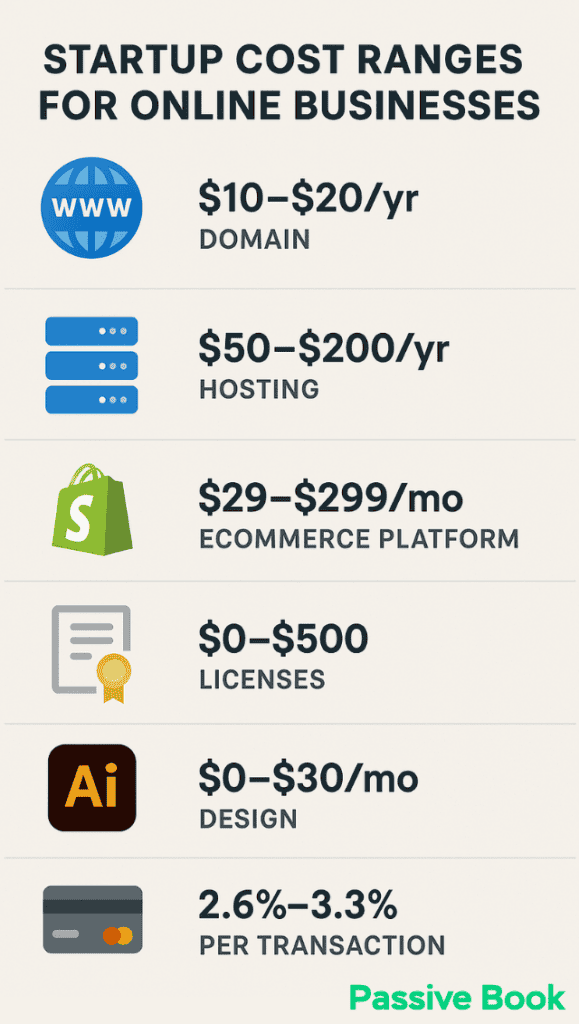
Key Startup Expenses
Starting an online business can be exciting, but knowing where to spend is key. Understanding the main costs will help you plan better and avoid surprises.
Business Licenses and Registration
Starting your online business begins with understanding the costs of business licenses and registration. These costs can vary significantly depending on the state and the type of business structure you choose. For instance, LLC fees can range from $0 to $500 annually, depending on the state, making it crucial to check specific state requirements. However, if you’re looking to save money, opting for states New Mexico might be beneficial as they not only have lower registration fees but also no annual fees.
Lowest Filing Fees: Montana ($35), Kentucky ($40), Arkansas, Arizona, Colorado, Hawaii, Iowa, Michigan, Mississippi, Missouri, and New Mexico (each at $50).
States with No Annual Fees: Arizona, Missouri, New Mexico, Ohio, and South Carolina (unless taxed as an S-Corp).
Highest Filing Fees: Massachusetts ($500), Nevada ($425), and California ($70) with a significant annual franchise tax.
States with High Annual Fees: California ($800), Massachusetts ($500), and Nevada ($350).

| State | Filing Fee | Annual / Biennial Fee | Notes |
|---|---|---|---|
| Alabama | $200 | $50 (annual) | |
| Alaska | $250 | $100 (biennial) | |
| Arizona | $50 | $0 | No annual report required |
| Arkansas | $45 | $150 (annual) | |
| California | $70 | $800 (annual) + $20 (biennial) | Includes $800 franchise tax and $20 Statement of Information every 2 years |
| Colorado | $50 | $25 (annual) | |
| Connecticut | $120 | $80 (annual) | |
| Delaware | $110 | $300 (annual) | |
| Florida | $125 | $138.75 (annual) | |
| Georgia | $100 | $50 (annual) | |
| Hawaii | $50 | $15 (annual) | |
| Idaho | $100 | $0 | Annual report required, no fee |
| Illinois | $150 | $75 (annual) | |
| Indiana | $95 | $31 (biennial) | |
| Iowa | $50 | $30 (biennial) | |
| Kansas | $160 | $50 (annual) | |
| Kentucky | $40 | $15 (annual) | |
| Louisiana | $100 | $35 (annual) | |
| Maine | $175 | $85 (annual) | |
| Maryland | $100 | $300 (annual) | |
| Massachusetts | $500 | $500 (annual) | |
| Michigan | $50 | $25 (annual) | |
| Minnesota | $155 | $0 | Annual report required, no fee |
| Mississippi | $50 | $0 | Annual report required, no fee |
| Missouri | $50 | $0 | No annual report required |
| Montana | $35 | $20 (annual) | |
| Nebraska | $100 | $13 (biennial) | |
| Nevada | $425 | $350 (annual) | |
| New Hampshire | $100 | $100 (annual) | |
| New Jersey | $125 | $75 (annual) | |
| New Mexico | $50 | $0 | No annual report required |
| New York | $200 | $9 (biennial) | |
| North Carolina | $125 | $200 (annual) | |
| North Dakota | $135 | $50 (annual) | |
| Ohio | $99 | $0 | No annual report required |
| Oklahoma | $100 | $25 (annual) | |
| Oregon | $100 | $100 (annual) | |
| Pennsylvania | $125 | $7 (annual) | |
| Rhode Island | $150 | $50 (annual) | |
| South Carolina | $110 | $0 | No annual report required unless taxed as an S-Corp |
| South Dakota | $150 | $50 (annual) | |
| Tennessee | $300 | $300 (annual) | |
| Texas | $300 | $0 | Annual Public Information Report required |
| Utah | $59 | $18 (annual) | |
| Vermont | $125 | $35 (annual) | |
| Virginia | $100 | $50 (annual) | |
| Washington | $200 | $60 (annual) | |
| Washington D.C. | $99 | $300 (biennial) | |
| West Virginia | $100 | $25 (annual) | |
| Wisconsin | $130 | $25 (annual) | |
| Wyoming | $100 | $60 (annual) |
Choosing the right business structure is also pivotal. Many solopreneurs prefer a sole proprietorship because it’s affordable and simple to set up. It requires minimal paperwork and offers straightforward tax reporting, allowing you to focus more on growing your business. You retain full control over your business decisions, providing flexibility without the need for extensive administrative tasks. This approach is particularly suited for those starting small with limited resources, as it helps keep initial costs manageable while you build your online presence.
Web Hosting and Ecommerce Platform
Starting an online business involves a few key initial expenses, particularly when setting up your website and choosing an ecommerce platform.
The best and cheapest way to build a website is through WordPress. If you self-host it, it is basically free and you only pay for the hosting. If you want to setup an ecommerce store, you can also install the Woocommerce plugin in WordPress and turn it into an ecommerce store.
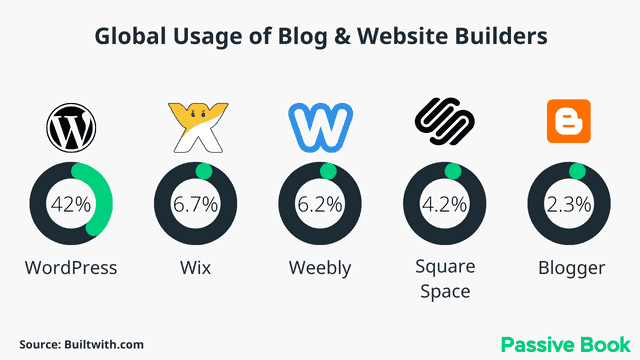
If you are self-hosting WordPress, web hosting is a crucial step, with costs typically ranging from $50 to $200 per year. Popular options like Bluehost and SiteGround offer affordable plans starting at $2.95/month and $2.99/month, respectively. These providers are well-regarded for their reliability, especially if you’re planning to build your site using WordPress, which is free and widely used by solopreneurs.
In addition to hosting, you’ll need a domain name. Domain registration usually costs between $10 and $20 per year, depending on the domain extension and the registrar you choose. Some registrars offer discounts if you commit to a longer-term contract, which can help you save money in the long run.
For those looking to create an online store, you can install the Woocommerce plugin in WordPress for free or alternatively use platforms like Shopify, which provide comprehensive solutions starting at $39/month. This includes everything from managing your inventory to processing payments. Shopify also offers discounts on annual plans, making it a cost-effective choice for solopreneurs. By carefully selecting your hosting and ecommerce platform, you can efficiently manage your startup costs while setting a strong foundation for your online business.
Website Design
Designing a website for your online business doesn’t have to empty your pockets. DIY website builders WordPress offer affordable solutions with themes that make website design easy and cost-effective. These platforms provide both free and premium themes, allowing you to choose based on your budget and needs. Premium themes generally start at $10 to $100 one-time fee. This flexibility means you can start without a hefty initial investment, an essential factor for solopreneurs with limited funds.
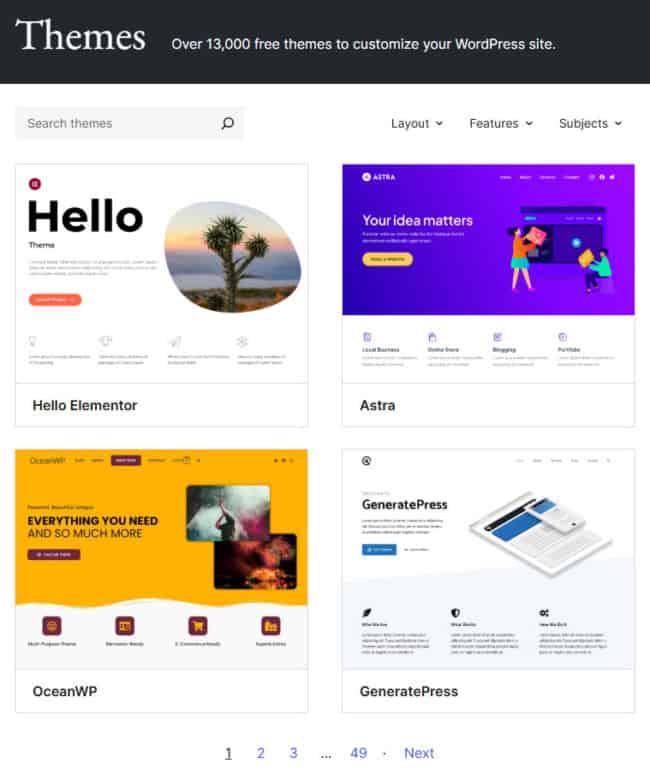
Using these themes, you can create a professional-looking site without hiring costly design services, saving thousands of dollars. WordPress offers themes that cater to different types of businesses, whether you’re setting up a blog, an online store, or a portfolio. This empowers you to focus your resources on other crucial areas like marketing or product development, ensuring that your business grows efficiently.
Moreover, many website builders offer free trials, so you can explore their features before committing financially. This approach not only helps in saving money but also in making informed decisions about the tools and resources that best suit your business model. By capitalizing on these DIY website builders, you can efficiently manage your startup costs, leaving room in your budget to spend money on other essential areas like product sourcing or marketing strategies.
Payment Processing
Choosing the right payment processor is crucial for your online business. Let’s take a look at some popular options: Square, PayPal, and Stripe. Each has its own fee structure that can impact your costs.
PayPal is widely recognized and trusted by many online shoppers. It charges a standard fee of 2.99% plus $0.49 for domestic transactions. If you deal with international customers, expect an extra 1.50% fee. Keep in mind that PayPal has additional charges for things like currency conversion and chargebacks.
| Provider | Online Payments | International Payments & Forex Fees | Notes |
|---|---|---|---|
| 2.9% + $0.30 per transaction | +1.5% for international cards +1% for currency conversion | No setup or monthly fees. Supports over 135 currencies. | |
| 3.49% + $0.49 per transaction | +1.5% for international transactions +3–4% currency conversion fee | No monthly fees for standard accounts. | |
 Square | 2.9% + $0.30 per transaction | 2.9% + $0.30 for non-EEA cards; + additional fees may apply based on region | Transparent pricing. No monthly fees. |
| 2.9% + $0.30 per transaction | +1.5% for international transactions | $25 monthly gateway fee. Requires merchant account. |
Meanwhile, Square is a great choice if you want free tools to manage your business. It charges 2.6% plus 10 cents for in-person transactions and 2.9% plus 30 cents per online transaction. If you send invoices, the fee is slightly higher at 3.3% plus 30 cents. They also offer custom pricing for businesses with high sales volumes.
Stripe is another popular option, especially for those handling international sales. For domestic transactions, it charges 2.9% plus 30 cents, with international cards incurring an additional 1.5% fee. Stripe also offers custom pricing for businesses with higher volumes, which can be a cost-saving option as your business grows.
By understanding these fees, you can choose the payment processor that best suits your business model and budget, which is essential for keeping your startup costs manageable.
Product Sourcing and Shipping
When starting an online business, one smart way to save money is to work with local suppliers. By choosing local partners, you can cut down on shipping costs and support the community around you. This means more of your money stays local, boosting the economy where you live. Using local suppliers also helps reduce carbon emissions, which is good for the planet.
Another tip is to skip shipping altogether by selling digital products. Digital products can be anything from e-books to online courses. They are easy to create and send to customers without worrying about boxes or delivery trucks. Plus, you don’t have to manage inventory or worry about running out of stock. This approach not only saves on shipping but also makes it easier to handle sales since everything is delivered online.

Marketing and Advertising
Marketing and advertising are important to get your online business noticed. Let’s see how you can use them wisely to grow your business.
Starting an online business doesn’t need to break the bank, especially when you leverage free tools and organic marketing strategies. You can kick off your content creation with free tools like Canva, which offers a free version that covers basic needs for social media and content creation. For more advanced features, Canva Pro costs around $12.99 per month, but starting with the free version can keep your initial costs low.

Organic marketing strategies are another cost-effective way to grow your online presence. These include SEO, partnerships, and leveraging social media to build authentic relationships and engaging content. By focusing on these organic channels, you can attract attention without spending thousands of dollars on ads. This approach is particularly beneficial for solopreneurs with limited budgets, as it allows you to grow your business without significant upfront costs.
Incorporating these strategies helps you create a robust marketing plan that aligns with your budget. By focusing on free and low-cost tools, you can invest your resources into other essential aspects of your business, ensuring a sustainable and manageable growth path.
Budget-friendly Online Business Ideas
Starting an online business can be affordable with the right ideas. This section shows options that won’t empty your pockets.
Content Creation
Content creation is the easiest and cheapest online business you can start. This includes being a creator on YouTube, Social Media or having a blog.
You can get started for very little to no money. All you need is a computer or phone and an internet connection. You can leverage free tools like Canva to create your designs.
You can monetize your content with ads, sponsorships, affiliate marketing or digital products like courses and books.
Dropshipping
Dropshipping is a popular way to run an online business without the need to hold inventory. With platforms like Shopify, you can start selling products with minimal upfront investment. Shopify‘s basic plan costs $29 per month, which is a manageable expense for solopreneurs aiming to start small. Additionally, you may need to consider costs like domain registration and web hosting, but these are relatively low compared to traditional retail models.
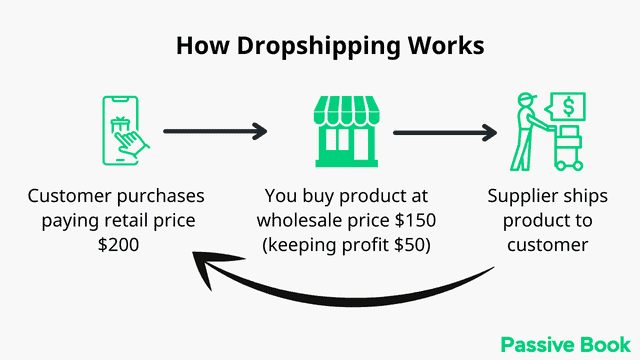
Using Shopify, you can connect to various dropshipping apps that help you find products to sell. These apps typically charge a small fee, but they save you time on managing inventory and shipping. As a solopreneur, your main focus can be on marketing your store and handling customer interactions, allowing you to run the business even with limited time each week. Remember, advertising will be a key expense, but platforms like social media offer affordable options to reach your audience effectively. With careful planning, you can start a dropshipping business without spending thousands of dollars upfront.
Affiliate Marketing
Affiliate marketing is a great way to start a business with minimal upfront costs. You typically need a website and some marketing materials, which won’t break the bank. Some people even use free tools to create a website, keeping expenses low. According to Adsterra, you’ll mainly be spending on a domain and hosting, which can be as low as $100 per year. This makes it an ideal choice if you’re on a budget but still want to make money online.
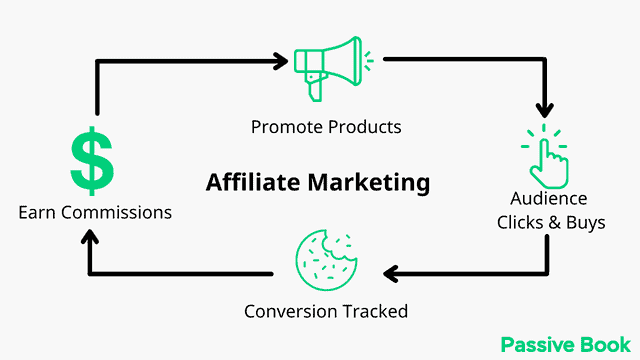
Tips for Cost Management
Managing costs is key to starting an online business. Let us look at some simple ways to save money.
Engaging Freelancers
When you’re starting an online business, finding affordable help can be crucial. Platforms like Upwork and Freelancer are popular choices for hiring freelancers who can assist with tasks like website design, content creation, and marketing. These platforms allow you to connect with skilled professionals from around the world, often at competitive rates. Besides these, options like Fiverr and PeoplePerHour also offer budget-friendly services, making it easier to get the help you need without spending thousands of dollars.
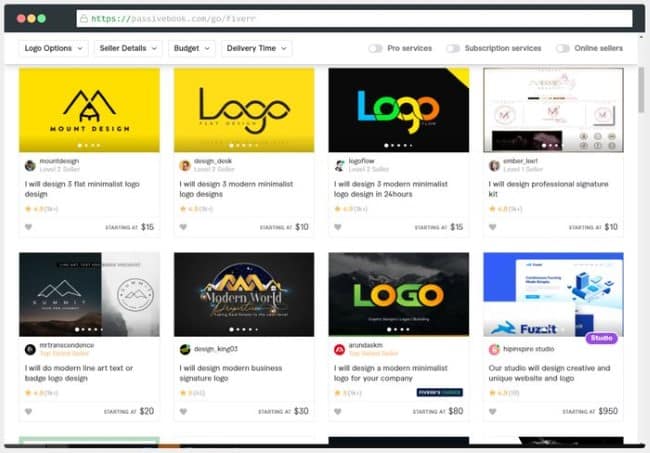
Using freelancers can be an effective way to manage tasks that you might not have the time or expertise to handle yourself. For instance, if you’re setting up an e-commerce store, a freelance web designer can create a custom website design tailored to your brand. This approach can save you money compared to hiring a full-time employee. Plus, it allows you to scale your business as needed by engaging freelancers on a project-by-project basis. This flexibility is especially helpful if you’re working with a limited budget and time, ensuring you only pay for the services you need when you need them.
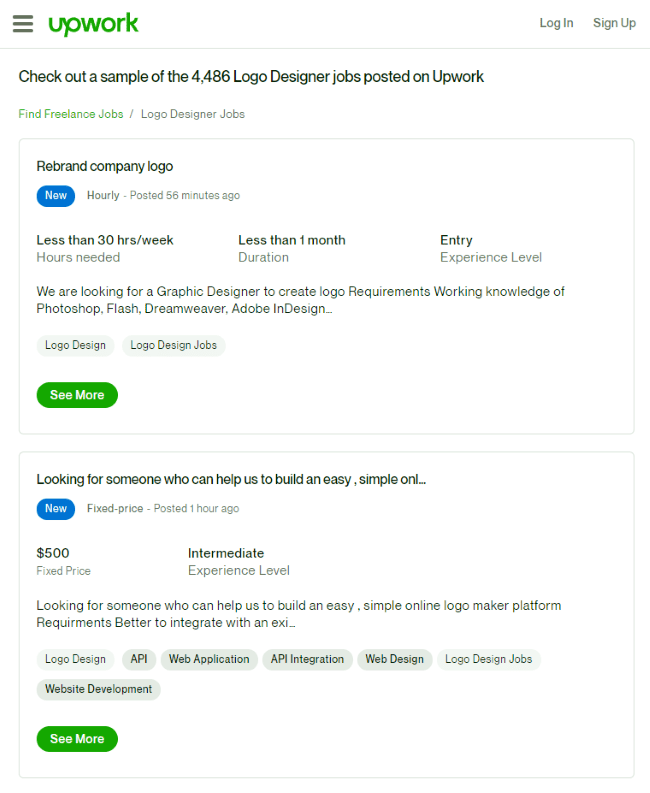
Utilize Free Tools
Starting an online business doesn’t have to cost thousands of dollars. You can save money by using free tools to manage your tasks and boost productivity. Buffer is a fantastic choice for social media management. With Buffer‘s free plan, you can schedule posts, access basic analytics, and manage up to three social media accounts. This helps you stay organized and maintain a consistent online presence without spending extra money.
For organizing projects, Trello offers a free plan that allows unlimited boards and cards, along with basic automation features. It’s perfect for keeping track of tasks and deadlines, ensuring you stay on top of your business goals. By utilizing these free resources, you can effectively manage your time and efforts, focusing on growing your online business without breaking the bank.
Implement Cost-effective Marketing
Creating a cost-effective marketing plan is key for solopreneurs who are starting small businesses on a tight budget. One effective way is to focus on content marketing and search engine optimization (SEO). By consistently creating helpful blog posts or videos that answer your audience’s questions, you can draw in visitors without spending money on ads. For instance, if you’re starting a blog about baking, sharing tips on making fluffy cakes can attract readers who are searching for baking advice. This strategy not only boosts your website’s visibility but also builds trust with your audience.
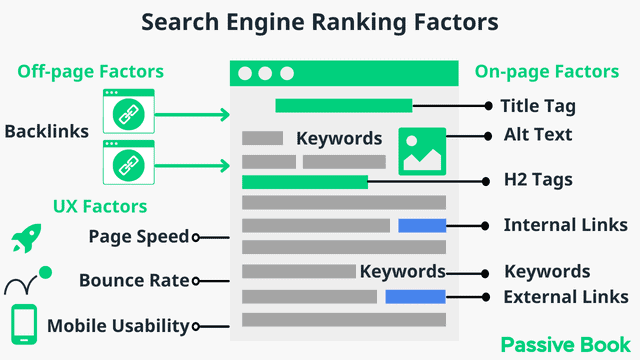
Another smart approach is to use email marketing. By gathering email addresses through a simple signup form on your website, you can send regular updates and promotions to your audience. This method keeps your business in their minds without the need for expensive marketing tools. Plus, using free email platforms like Mailchimp can save you money while still reaching a wide audience. According to Root Rise Marketing, email marketing is a powerful tool that connects you directly with potential customers at a low cost.
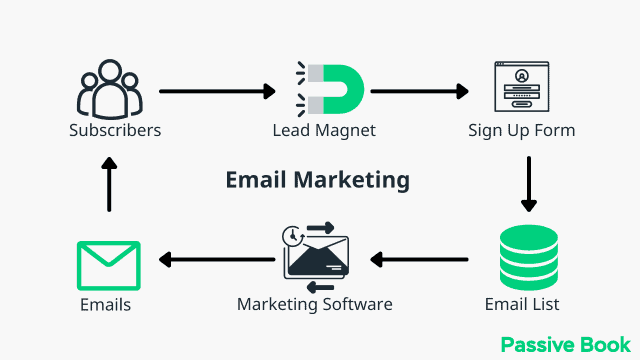
Social media engagement is also a highly cost-effective marketing strategy. By regularly posting and interacting with followers on platforms like Instagram or Facebook, you can expand your reach organically. Engaging with comments and messages helps build a community around your brand, encouraging word-of-mouth promotion. These tactics not only save money but also help you grow your business by fostering genuine connections with your audience.
Exploring E-commerce Platforms
When choosing an e-commerce platform, it’s important to consider what suits your needs best. If you’re looking to build a robust online store, Shopify and Woocommerce are top picks for serious ecommerce businesses. It offers comprehensive ecommerce features like inventory management and payment processing that make it easier to run an online business effectively. However, Shopify can be more expensive as the costs can add up depending on the features you choose.
Woocommerce is free and is a plugin that you install in WordPress. But it is slightly more technical to use and maintain because you have to self host it to yourself.
Print on Demand Business Model
Starting a print-on-demand (POD) business is a smart choice for solopreneurs looking to supplement their income with minimal upfront costs. Platforms like Printify allow you to start without any initial investment. You simply upload your designs, and the platform takes care of printing and shipping. This means you don’t have to worry about managing inventory or warehousing products, which saves you both time and money.
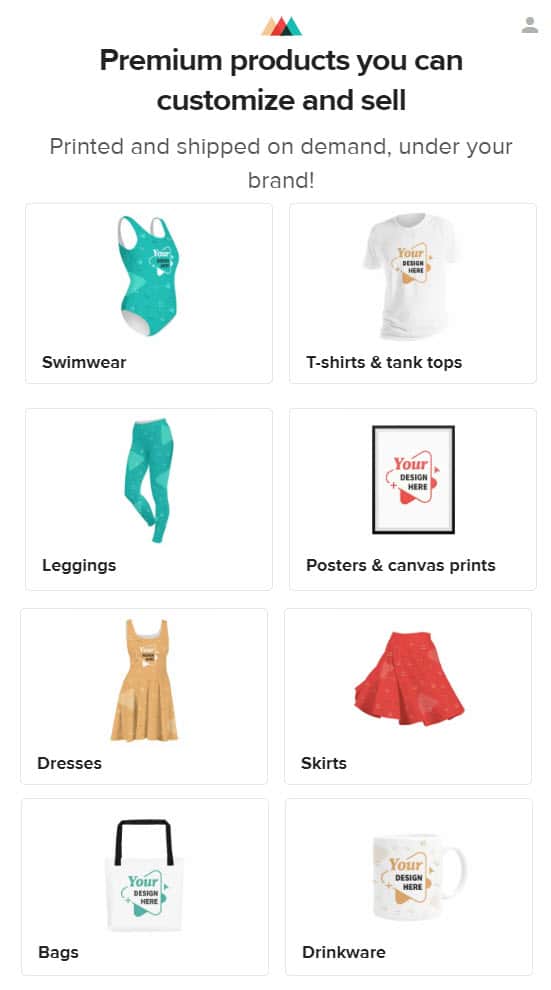
Print-on-demand reduces the risk of excess inventory because products are only created when a customer places an order. This flexibility allows you to experiment with different designs and products without the financial burden of unsold stock. Additionally, the model is highly scalable. As your online store grows, you can easily expand your product range or reach a global audience without significant additional costs. This business model also supports easy scaling and global reach, making it ideal for new entrepreneurs eager to grow their business efficiently.
For those with limited time and budget, print-on-demand is a viable way to enter the e-commerce space with minimal risk. It provides a platform to showcase creativity while leveraging existing business resources to handle production and logistics. This lets you focus on developing engaging marketing strategies to drive online sales and grow your business.
Frequently Asked Questions
Let us clear up common doubts entrepreneurs have.
Can I Start an Online Business Without Money?
Yes, you can start an online business without money. Use free tools like social media to market your brand. Create content or offer services using free platforms, and reinvest any early profits to grow.
What Is the Cheapest Online Business to Start?
Starting a blog or YouTube channel can be the cheapest online businesses to start. You only need a computer and internet access. You can use free platforms like WordPress to publish your work.
Is Running an Online Business Challenging?
Running an online business can be challenging because it requires time and effort. You need to manage different tasks like marketing, customer service, and keeping the website updated. It’s important to stay organized and learn new skills to keep your business running smoothly.
What Are the Basic Costs to Start an Online Business?
You will need to spend money on a domain name and web hosting. A basic website design might also cost a bit. Don’t forget about things like business licenses and registration fees.
How Can I Minimize the Cost of Starting an Online Business?
Use free tools like Canva for emails and document management. Opt for open-source website builders like WordPress to save on design costs. Start marketing on social media to reach people without spending money.
Are There Any Ongoing Costs in Running an Online Business?
Yes, there are ongoing costs. You need to pay for web hosting, domain renewal, and any ecommerce platform fees. You might also spend money on marketing and software tools to keep your business running.
What Next?
Starting an online business might seem tricky, but now you know the costs. I hope this article helped you figure out what you need to spend. If you still have questions, ask them in the comments below.
Think about what kind of online business suits you best. Share your ideas in the comments. It’s okay if it feels tough; many people feel the same way. Just remember, you can do it.
Why not make your own plan based on what you learned here? Try using the tips to save money. And if you found this article useful, share it with friends using the buttons below. They might find it helpful too.
Share this post with your friends & followers:
